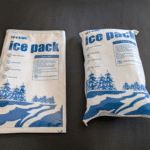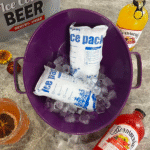Versand mit Trockeneis ist eine effiziente Möglichkeit, temperaturempfindliche Produkte aufrechtzuerhalten, wie gefrorene Lebensmittel oder medizinische Proben, Kälte während des Transits. Verstehen, wie man mit Trockeneis umgeht, seine ordnungsgemäße Verwendung, und regulatorische Anforderungen sind entscheidend für die Gewährleistung einer sicheren und konformen Schifffahrt. Dieser Leitfaden bietet alle wesentlichen Schritte für den Versand mit Trockeneis.
-
Was ist Trockeneis und wann sollten Sie es verwenden??
-
Wie können Sie Trockeneis sicher umgehen und speichern??
-
Was sind die Vorschriften für den Versand mit Trockeneis??
Was ist Trockeneis und wann sollten Sie es verwenden??
Trockeneis, oder festes Kohlendioxid, hat eine extrem niedrige Temperatur von -109,3 ° F. (-78.5°C) und Sublimes direkt von einem Feststoff zu einem Gas. Es wird häufig für Versandprodukte verwendet, die gefroren bleiben müssen, wie Lebensmittel und medizinische Versorgung. Jedoch, Die Verwendung von Trockeneis ist nicht immer notwendig und könnte für einige Produkte übermäßig sein.
Wann man Trockeneis benutzt:
Für empfindliche Gegenstände wie gefrorene Lebensmittel und Biologika, Trockeneis ist die beste Wahl. Für weniger sensible Produkte, Andere Kältemittel könnten ausreichen. Wenden Sie sich immer an einen Versandanbieter, wie ups, Um die am besten geeignete Versandlösung basierend auf den Temperaturanforderungen des Produkts zu bestimmen.
Sicheres Handling von Trockeneis
Der Umgang mit Trockeneis erfordert Vorsicht aufgrund seiner extremen Kälte. Tragen Sie immer Schutzhandschuhe, Brille, und Kleidung, die einen direkten Kontakt mit der Haut verhindern. Trockeneisverbrennungen können genauso leicht auftreten wie Verbrennungen aus einem Gefrierschrank oder Eis.
| Handhabungsbedarf | Beschreibung | Nutzen |
|---|---|---|
| Schutzhandschuhe | Verwenden Sie isolierte Handschuhe | Verhindert Hautverbrennungen |
| Brille | Tragen Sie Sicherheitsbrillen | Schützt die Augen vor Eispartikeln |
| Richtige Kleidung | Tragen Sie lange Ärmel | Vermeiden Sie direkten Hautkontakt |
Was sind die Versandvorschriften für Trockeneis?
Beim Versand von Trockeneis, Sowohl inländische als auch internationale Vorschriften müssen befolgt werden. In den USA, Trockeneis -Sendungen unterliegen den Sendungen 49 CFR 173.217, die Verpackungen angeben, Beschriftung, und Dokumentation. International, IATA -Vorschriften Trockeneistransport regieren, Erfordernis der Einhaltung der Packungsanweisungen 954. Sie müssen die Sendung korrekt beschriften, das Vorhandensein von Trockeneis anzeigen und sicherstellen, dass die Packung ordnungsgemäß entlüftet wird.
Beispiel für reale Welt: Beim Versand einer medizinischen Stichprobe nach Europa, Wir haben dafür gesorgt, dass alle Pack- und Kennzeichnungsanforderungen erfüllt wurden, Verzögerungen am Zoll verhindern. Das Paket kam sicher an, und die Inhalte blieben während der gesamten Reise bei der richtigen Temperatur.
Wie man trockenes Eis sicher behandelt und speichert
Das Speichern von Trockeneis erfordert spezialisierte Behälter. Sie können keine luftdichten oder Glasbehälter verwenden, Wenn das während der Sublimation freigelassene Gas zu einem gefährlichen Druckaufbau führen kann. Lagern Sie immer Trockeneis in gut belüfteten Bereichen, damit das Gas sicher fliehen kann.
Speicherrichtlinien:
-
Verwenden Sie belüftete Behälter, um Druckanbau zu vermeiden.
-
In einem Cool speichern, gut belüfteter Raum.
-
Lagern Sie niemals in geschlossenen Räumen wie Kühlschränken oder Gefrierschränken.
Berechnen Sie, wie viel Trockeneis zu bedienen ist
Die erforderliche Menge an Trockeneis hängt von der Dauer der Sendung und der verwendeten Isolierung ab. In der Regel, 5 Zu 10 Pfund Trockeneis sublimieren jeden 24 Std.. EPS-Schaum mit höherer Dichte verlangsamt die Sublimation, Passen Sie also also entsprechend anhand der von Ihnen ausgewählten Verpackung an.
| Verpackungsmaterial | Sublimationsrate | Versanddauer | Idealer Gebrauch |
|---|---|---|---|
| EPS -Schaum (Hohe Dichte) | Langsamer Sublimation | 2+ Tage | Ideal für längere Sendungen |
| EPS -Schaum (Niedrige Dichte) | Schneller Sublimation | 1 Tag | Für kurze Sendungen oder schnelle Transit |
Was sind die besten Verpackungspraktiken für Trockeneis -Sendungen?
Mit Trockeneis packen, verwenden erweiterter Polystyrol (EPS) Schaum für Isolierung, und legen Sie den Inhalt in einen robusten, Wellkarton. Stellen Sie sicher, dass Ihr Produkt getrennt vom Trockeneis platziert wird, und vermeiden Sie es, die Schachtel vollständig zu versiegeln, damit das Gas entweichen kann.
Packtipps:
-
Lassen Sie Produkte nicht trockenes Eis berühren - Dies kann sie beschädigen oder einfrieren.
-
Vermeiden Sie es, die Schachtel luftdicht zu versiegeln - Gase entweichen lassen, um Explosion zu verhindern.
Versandtipps für verschiedene Produkte
Für Essen, Es ist wichtig, es sicher zu packen, um die Frische zu bewahren. Für sensible medizinische Sendungen, Möglicherweise benötigen Sie spezielle Verpackungsoptionen, Wie UPS HealthCare ™ Cold -Kettenverpackung, Dadurch bleiben die Produkte auf einer genauen Temperatur.
Praktischer Fall: Für Versand gefrorener Essen, Wir haben EPS -Schaumbehälter verwendet und das Essen sorgfältig gepackt, um den Gefrierschrank zu vermeiden, Gewährleistung seiner Ankunft in perfektem Zustand.
Was sind die Versandvorschriften für Trockeneis?
Für Luftversand in den USA, Trockeneis muss ordnungsgemäß beschriftet und dokumentiert werden 49 CFR 173.217. Internationale Sendungen unterliegen von Iata Vorschriften, einen unterschriebenen benötigen Internationale Sondergüter (ISC) Vertrag.
Wie man Trockeneisausgänge korrekt beschriftet
Beim Versand von Trockeneis, Der Behälter muss mit einem gekennzeichnet sein “Trockeneis” Etikett, und Sie müssen auch a einbeziehen UN1845 Kennung auf dem Paket. Stellen Sie sicher, dass alle Sendungen den lokalen und internationalen Vorschriften entsprechen, um Verzögerungen und Geldstrafen zu vermeiden.
Neueste Trends in der Kaltkette Versand
In 2025, Wir sehen Fortschritte in den Arten von Materialien, die zum Verpacken von Trockeneis verwendet werden, Welche langsamen Sublimationsraten und verlängern die Versanddauer. Die High-Tech-Verpackung ermöglicht eine bessere Überwachung und Kontrolle der Temperaturen während des Transports.
Neueste Entwicklungen in Kaltkettenverpackungen:
-
Intelligente Verpackungslösungen: Echtzeit-Temperaturüberwachung hilft sicherzustellen, dass die Produkte innerhalb des erforderlichen Temperaturbereichs bleiben.
-
Fortgeschrittene Isolierung: Neue EPS-Schäume mit hoher Dichte erweitern die Haltbarkeit von Produkten während des Versands.
Häufig gestellte Fragen
Was ist der ideale Temperaturbereich für den Versand von Lebensmitteln mit Trockeneis?
Die Temperatur für den Lebensmittelversand sollte normalerweise unter 0 ° F gehalten werden (-18°C). Trockeneis behält die Nahrung während des Transports bei dieser Temperatur bei, sicherzustellen, dass es gefroren und sicher bleibt.
Kann ich Trockeneis mit Höheneis versenden??
Ja, UPS bietet spezielle Dienstleistungen für den Versand von Trockeneis an, einschließlich Verpackung, Beschriftung, und Temperaturkontrolloptionen.
Schlussfolgerung und Aktionsschritte
Um zusammenzufassen, Der Versand mit Trockeneis erfordert sorgfältige Planung und Einhaltung von Sicherheitsrichtlinien und -vorschriften. Gewährleisten Sie das richtige Handling, Wählen Sie die richtige Verpackung, und beschriften Sendungen genau, um Komplikationen zu vermeiden. Wenn Sie sich nicht sicher sind, Wenden Sie sich an Experten, um die beste Lösung für Ihre Bedürfnisse zu ermitteln.
Nächste Schritte:
-
Stellen Sie sicher, dass Ihre gesamte Verpackung den Vorschriften entspricht.
-
Berechnen Sie die korrekte Menge an Trockeneis basierend auf den Bedürfnissen der Sendung.
-
Wenden Sie sich an Ihren Versandanbieter für maßgeschneiderte Kaltkettenlösungen.
Über Tempk
Tempk ist ein führender Anbieter von temperaturgesteuerten Versandlösungen. Wir sind auf Kaltkettenlogistik spezialisiert, Bieten Sie fortschrittliche Verpackungen und zuverlässige Dienstleistungen an, um den sicheren Transport sensibler Produkte zu gewährleisten. Mit unserem Fachwissen, Sie können sicher sein, dass Ihre Produkte während des Transports in optimalem Zustand bleiben.
Kontaktieren Sie uns: Für fachkundige Beratung zu Trockeneisschifffahrts- und Kaltkettenlösungen, Machen Sie sich heute mit uns in Verbindung.

























